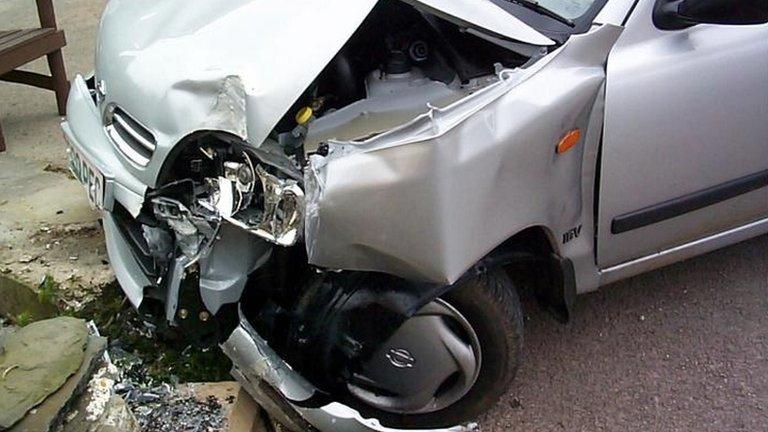Warning over drug-driving law and prescribed medication
- Published

Drivers are being warned over the effects of some powerful prescription drugs
People who have been prescribed powerful anxiety or pain relief drugs are being warned about a new drug-driving law.
As well as outlawing driving while under the influence of illegal drugs, new legislation will include some prescription medicines.
But prescribed doses do not exceed the limits for legal drugs, so most patients should still be safe to drive.
Those who are unsure are advised to seek the advice of a pharmacist.
The new law, to be introduced 2 March 2015 in England and Wales, aims to catch those who put the lives of others at risk while driving under the influence of drugs.
It sets very low levels for eight well known illegal drugs, including cannabis and cocaine, but also includes eight prescription drugs, where the levels have been set much higher.
Most of them, including Temazepan and Diazepam, are used for treating conditions such as anxiety.
But the list also includes methadone, a heroin substitute and pain medication, and morphine, a powerful opiate also used for pain relief.
Robert Goodwill MP, Road Safety Minister, says as long as they stay within prescribed levels, most people will still be able to get behind the wheel of a car.
"If you are taking your medicine as directed and your driving is not impaired, then you are not breaking the law and there is no need to worry," he said.
"We advise anyone who is unsure about the effects of their medication or how the new legislation may affect them, to seek the advice of their doctor or pharmacist.
"There will also be a medical defence if a driver has been taking medication as directed and is found to be over the limit but not impaired.
"Drivers who are taking prescribed medication at high doses [are advised] to carry evidence with them, such as prescriptions slips, when driving in order to minimise any inconvenience should they be asked to take a test by the police."
Get advice
Prof David Taylor, a spokesman for the Royal Pharmaceutical Society and a member of the Department for Transport advisory panel on drug-driving said "Don't stop taking your medicines, prescribed or otherwise, if you are worried about this new law.
"Instead, talk to your doctor or pharmacist for information about how your medicines might affect your ability to drive.
"They'll be happy to give you the advice you need to stay safe."

Prescription drugs covered by the new law
Clonazepam is prescribed to treat seizures or panic disorders
Diazepam is used for anxiety disorders, alcohol withdrawal symptoms or muscle spasms
Flunitrazepam (also known as Rohypnol) is a sedative originally used in hospitals for deep sedation in the 1970s
Lorazepam is used to treat convulsions or seizures caused by epilepsy
Oxazepam is used to relieve anxiety, including anxiety caused by alcohol withdrawal
Temazepam affects chemicals in the brain that may become unbalanced and cause insomnia problems
Methadone is used in the treatment of heroin addiction and for pain relief
Morphine or opiates treat moderate to severe pain

Ed Morrow, campaigns officer for road safety charity Brake said the organisation strongly welcomed the new drug-diving law.
"This much-needed progressive move by government will make it much easier for police to deal with illegal drug-drivers," he said.
"We are confident that the necessary measures are in place to ensure drivers who take prescription medication are not unfairly penalised.
"However, many prescription medications can have a negative effect on your ability to drive safely, and there is a worrying lack of awareness of this among the public."
- Published21 December 2014

- Published4 January 2013

- Published7 May 2012
